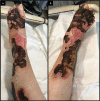Burn Center Management of Severe Necrotic Cutaneous Polyarteritis Nodosa in a Patient With a History of Thymoma
- PMID: 33728150
- PMCID: PMC7935156
- DOI: 10.7759/cureus.13134
Burn Center Management of Severe Necrotic Cutaneous Polyarteritis Nodosa in a Patient With a History of Thymoma
Abstract
Cutaneous polyarteritis nodosa (cPAN) is a rare, necrotizing vasculitis involving the small- and medium-sized vessels of the dermis and subcutaneous tissues. We report a severe case of cPAN in a patient with an atypical presentation of extensive bilateral lower extremity ulcerations with full-thickness necrosis managed at a burn center. A 70-year-old female with a three-month history of necrotizing cPAN to the bilateral lower extremities underwent surgical excision and autografting at an outside hospital. Postoperatively, she had total graft loss and was begun on prednisone. In the outpatient setting, she was tapered off prednisone and subsequently began to experience an acceleration of the disease process. She was then transferred to our regional burn center for bilateral escharotomy and management of her non-healing, tender, necrotic wounds with distinctive black-brown eschar. One year later, the patient's wounds continue to decrease in size and heal with her daily regimen of 15 mg of prednisone, 50 mg of cyclophosphamide, and topical silver sulfadiazine application. With the increasing volume of non-burn wound admissions to burn centers primarily of dermatologic etiology, it becomes crucial for burn specialists to familiarize themselves with severe presentations of vasculitides, including cPAN. Further research is necessary to understand the atypical manifestations of this disease for more timely diagnosis and treatment.
Keywords: autoimmune; cpan; cutaneous polyarteritis nodosa; gangrene; necrosis; polyarteritis nodosa; thymoma; ulceration.
Copyright © 2021, Abousy et al.
Conflict of interest statement
The authors have declared that no competing interests exist.
Figures


Similar articles
-
Cutaneous polyarteritis nodosa and pulmonary arterial hypertension: An unexpected liaison. A case report.Medicine (Baltimore). 2023 Dec 15;102(50):e36563. doi: 10.1097/MD.0000000000036563. Medicine (Baltimore). 2023. PMID: 38115264 Free PMC article.
-
Cutaneous polyarteritis nodosa: A rare isolated cutaneous vasculitis.Indian Dermatol Online J. 2012 Jan;3(1):21-4. doi: 10.4103/2229-5178.93488. Indian Dermatol Online J. 2012. PMID: 23130255 Free PMC article.
-
Cutaneous polyarteritis nodosa in a child.Pediatr Dermatol. 1998 Mar-Apr;15(2):103-7. doi: 10.1046/j.1525-1470.1998.1998015103.x. Pediatr Dermatol. 1998. PMID: 9572691 Review.
-
A rare case of Polyarteritis Nodosa associated with autoimmune hepatitis: a case report.BMC Rheumatol. 2021 May 26;5(1):17. doi: 10.1186/s41927-021-00188-1. BMC Rheumatol. 2021. PMID: 34034829 Free PMC article.
-
Distal extremity necrosis as a manifestation of cutaneous polyarteritis nodosa: case report and review of the acute management of a pediatric patient.Pediatr Dermatol. 2012 Jul-Aug;29(4):473-8. doi: 10.1111/j.1525-1470.2011.01515.x. Epub 2012 May 21. Pediatr Dermatol. 2012. PMID: 22612230 Review.
References
-
- Cutaneous periarteritis nodosa: a clinicopathological study of 79 cases. Daoud MS, Hutton KP, Gibson LE. Br J Dermatol. 1997;136:706–713. - PubMed
-
- Cutaneous polyarteritis nodosa: a comprehensive review. Morgan AJ, Schwartz RA. Int J Dermatol. 2010;49:750–756. - PubMed
-
- Acral necrosis of the fingers as initial manifestation of cutaneous polyarteritis nodosa: a case report. Stussi G, Schneider E, Trüeb RM, Seebach JD. Angiology. 2001;52:63–67. - PubMed
-
- Management of severe rheumatological disease in the burn center. Reddy P, Ahrenholz DH, Mohr WJ, Gertner E. J Burn Care Res. 2012;33:154–160. - PubMed
Publication types
LinkOut - more resources
Full Text Sources
Other Literature Sources
